A subcontractor that allegedly broke the law in the surprise partial demolition of the Agenna Shipyard in Keelung said that it planned to repurpose the area to enhance the city’s tourism beltway, with the demolition taking place to remove buildings that posed a threat to the public.
The shipyard was recently brought to public attention due to the 2014 filming of a trailer for Call of Duty Online, part of the first-person shooting game franchise Call of Duty, starring US actor Chris Evans, who is best known for his portrayal of the lead role in the Captain America movie franchise.
The subcontractor, which leased the land from Taiwan Sugar Co (Taisugar, 台糖) in 2008, allegedly violated Article 86 of the Building Act (建築法) when it moved two excavators to the site on Monday afternoon to remove the ruins.
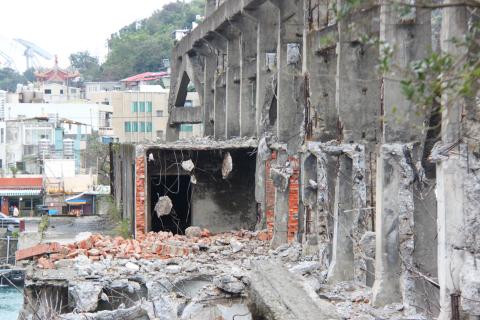
Photo: Lin Hsin-han, Taipei Times
Article 86-3 stipulates that the unauthorized removal of buildings can result in a maximum fine of NT$10,000.
The subcontractor’s representative, Hsu Shu-ming (許書銘), said it had conducted inspections of the ruins and deemed them too old to be directly repurposed, adding that the demolition was aimed at making the area safer, especially following the magnitude 6.4 earthquake on Feb. 6.
The original plan was to keep the shipyard and open a theme restaurant nearby, but the ruins, while eligible for reinforcing, might have become rotten inside, which would have greatly increased overheads and posed a safety risk, Hsu said, adding that plans were later stalled when the city government was considering building a light-rail system nearby.
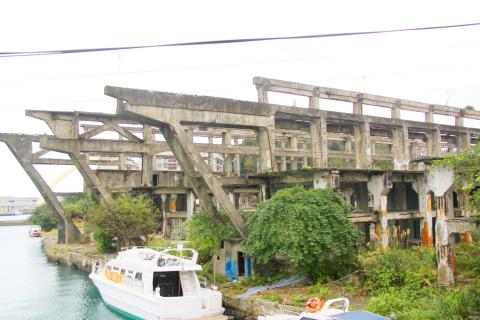
Photo: Lin Hsin-han, Taipei Times
Keelung Mayor Lin Yu-chang (林右昌) on Monday night on Facebook condemned the demolition and rejected the notion that the city government had knowledge of the subcontractor’s plans.
Anyone that shows so much disrespect for local buildings and their historical significance should be condemned, Lin said.
Lin said the city government would fine the subcontractor, as it did not apply for a permit to remove or demolish the building.
The city government has also demanded that the subcontractor cease all demolition work and apply for a permit, Lin said, adding that the city would do its utmost to preserve an “important remnant of Keelung’s early industry.”
Although the ruins are on private property, they are still an important part of the city’s history and should be conserved, Lin said, adding with regret that Monday’s abrupt demolition work might have marred the bright future repurposing could have given the shipyard.
However, the shipyard has not been named a historical heritage site and sits on land owned by Taisugar, which obtained it from now-defunct Taiwan Metals Mining Co (台金公司).
Meanwhile, Taisugar department of public relations director Liu Tsung-hsien (劉宗憲) said that the company had made clear to the subcontractor the parameters for development of the site.
There are no plans to develop the land around the shipyard’s ruins, Liu said, adding that Taisugar would release more information after clarifying details with the subcontractor.
The shipyard, next to Heping Bridge (和平橋), which connects Keelung and Heping Island (和平島), was originally owned and used by Japanese companies during the Japanese colonial era to expedite the transportation of gold from the Jinguashih (金瓜石) area in what is now New Taipei City. It derives its name from a US yacht manufacturing firm that had leased the property from Taiwan Metals Mining.
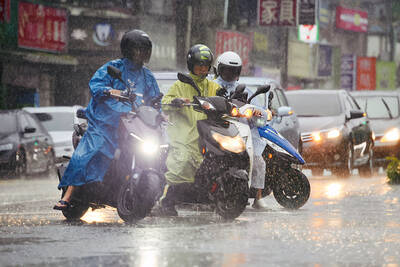
The combined effect of the monsoon, the outer rim of Typhoon Fengshen and a low-pressure system is expected to bring significant rainfall this week to various parts of the nation, the Central Weather Administration (CWA) said. The heaviest rain is expected to occur today and tomorrow, with torrential rain expected in Keelung’s north coast, Yilan and the mountainous regions of Taipei and New Taipei City, the CWA said. Rivers could rise rapidly, and residents should stay away from riverbanks and avoid going to the mountains or engaging in water activities, it said. Scattered showers are expected today in central and

COOPERATION: Taiwan is aligning closely with US strategic objectives on various matters, including China’s rare earths restrictions, the Ministry of Foreign Affairs said Taiwan could deal with China’s tightened export controls on rare earth metals by turning to “urban mining,” a researcher said yesterday. Rare earth metals, which are used in semiconductors and other electronic components, could be recovered from industrial or electronic waste to reduce reliance on imports, National Cheng Kung University Department of Resources Engineering professor Lee Cheng-han (李政翰) said. Despite their name, rare earth elements are not actually rare — their abundance in the Earth’s crust is relatively high, but they are dispersed, making extraction and refining energy-intensive and environmentally damaging, he said, adding that many countries have opted to
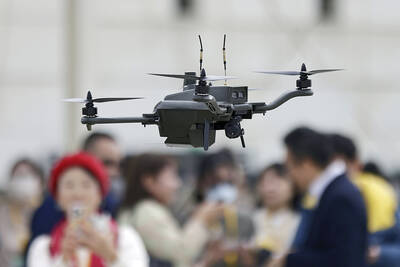
SUPPLY CHAIN: Taiwan’s advantages in the drone industry include rapid production capacity that is independent of Chinese-made parts, the economic ministry said The Executive Yuan yesterday approved plans to invest NT$44.2 billion (US$1.44 billion) into domestic production of uncrewed aerial vehicles over the next six years, bringing Taiwan’s output value to more than NT$40 billion by 2030 and making the nation Asia’s democratic hub for the drone supply chain. The proposed budget has NT$33.8 billion in new allocations and NT$10.43 billion in existing funds, the Ministry of Economic Affairs said. Under the new development program, the public sector would purchase nearly 100,000 drones, of which 50,898 would be for civil and government use, while 48,750 would be for national defense, it said. The Ministry of
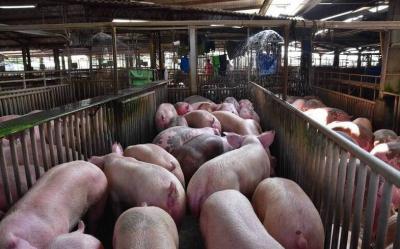
African swine fever was confirmed at a pig farm in Taichung, the Ministry of Agriculture said today, prompting a five-day nationwide ban on transporting and slaughtering pigs, and marking the loss of Taiwan’s status as the only Asian nation free of all three major swine diseases. The ministry held a news conference today confirming that the virus was detected at a farm in Wuci District (梧棲) yesterday evening. Authorities preemptively culled 195 pigs at the farm at about 3am and disinfected the entire site to prevent the disease from spreading, the ministry said. Authorities also set up a 3km-radius control zone